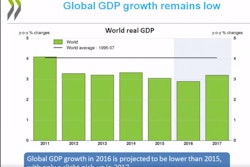
Despite the virtues of the global economy, production now outstrips planetary boundaries and the environment is now contending with mass-scale pollution. The Pacific trash vortex, a gyre of plastic debris the size of Texas in the central North Pacific Ocean, alone suggests that things aren’t too symbiotic between humans and nature.
Meanwhile, decades of effort focused on sustainability and corporate responsibility initiatives struggle to make a difference—with mixed results. Can we safely say we are closer to sustainable success? Not quite. “Companies can’t be sustainable in an unsustainable society,” argues a recommended blog post on GreenBiz: A gold standard for truly sustainable enterprises.
One area that could have a bigger impact than all of the above, though, is how we think about goods, and what constitutes input and output in a modern supply chain. Today’s supply chains are linear: They consume materials; move products from manufacturing, distribution and selling; and then most often products are scrapped after a while and land on the scrap heap.
There’s growing consensus that the only way forward with sustainable production and growth is to switch from our current industrial linear model to one that is less dependent on primary energy and natural resources, and is also regenerative to reduce waste. This is known as the circular economy. In plain terms, it means: “For a product, the onus is on the manufacturer who needs to take care of the resources used in its products, so it keeps the metals, plastics, etc. in use within the product cycle for as long as possible, and thinks about design for longevity, repair and reuse,” said CEO of Wrap, Liz Goodwin in a Guardian article.
There are strong signs that the circular economy is going to have an impact within business as well. Organizations like McKinsey, Ellen MacArthur Foundation, and an array of large companies like Accenture and Philips are getting behind the idea. Companies on the forefront of this wave, they say, can unleash innovations such as new product-to-service approaches, new materials recovery methods, and smarter projections and preparedness for future costs, such as waste disposal or raw materials prices.
While it may take years or decades before the ultimate vision of the circular economy takes hold and we see economic growth without the increased use of natural resources, there are strong signals in the tech realm that point to the acceleration of this trend. That’s because they’re based on the same principles, but are enabled much faster due to the fast innovation cycles in tech.
The Sharing Economy
The sharing economy is made up of hundreds of compelling new businesses, including Uber, AirBnB, Lyft and Kickstarter, which are transforming how goods and services are concepted, created, procured and sold—in fact, changing the whole distribution model. They present a new approach that is more efficient, and helps many people get access to resources, grow them and share them with a community. This is all made possible by changing consumer preferences. Why own when you can rent? The result is less waste and greater utilization, which is good for the environment.
The trio of Internet ubiquity, cloud computing and mobile broadband is what makes the sharing economy possible. Similarly, content subscription services like Netflix and Spotify are displacing many physical goods with on-demand digitized alternatives. And software-as-a-service (SaaS) models allow companies to forego owning information technology (IT) infrastructure, ultimately reducing the footprint of their hardware and electricity use.
But it’s not just technology companies. In recent years, major manufacturing companies like Rolls Royce and Caterpillar started the transition from manufacturing to managed services, taking care of product lifecycles end to end. Today, you no longer buy a Rolls Royce jet engine: You lease it and the British manufacturer manages the process end to end, installing, servicing, monitoring in the air, replacing and recycling parts, and ultimately delivering a service, not just a product. Again, we see these trends having a net positive impact on the environment.
The Circular Supply Chain
While this trend is positive, it’s putting great demands on the modern supply chain. The world’s largest enterprises also have the largest manufacturing operations and largest supply chains. Therefore, they stand to benefit the most, while offering the greatest support for the circular economy—if they can overcome the complex challenges of running a circular supply chain.
Recent research shows that it’s worth the upside. Business leaders—specifically procurement executives—should develop an expert understanding of how to capture commercial value across supply chains by closing materials loops and regenerating natural assets, while working with other parts of the organization to analyze the merits of a circular supply chain.
In a detailed report, the World Economic Forum (WEF) said: “Analyzing the most advanced business cases confirms that a supply chain management approach that balances the forward and reverse loops, and ensures uniform materials quality is critical to maximizing resource productivity globally. The transition can begin once the hinge points are identified and acted upon in a concerted effort—across companies, geographies and along the supply chain.” Identifying these hinge points means that businesses first have to get a complete understanding of their supply chains all the way to the roots, including all the moving parts.
The complexity of the supply chain in a circular economy vs. a linear one is like day and night. Leaders have to rethink their supply chain economy as a network, not as a collection of single companies. The interdependence between companies is going to be suddenly much higher, which means they have to better choreograph the movement between materials and goods. Often, the biggest barrier in modern supply chains is communication: Can you handle all these transactions in a seamless way, enabling your partners and suppliers to coordinate more efficiently?
Below are considerations for anyone interested in creating a circular supply chain:
- Outputs become inputs because your goods don’t end their life with their customers, but become an input in your supply chain. Practically speaking, this means your accounts payable and accounts receivable processes will form a loop instead of a straight line.
- Without a digital supply chain, it will be almost impossible to coordinate all the moving parts a circular supply chain requires in real time. (The paper spend in a modern supply chain is also not really compatible with the positive effects of participating in a circular economy.)
- Assess your suppliers and work with the top tier for a common vision and goals toward a circular supply chain. Trace your supply chain to the bottom to ensure your corporate social responsibility (CSR) standards are met as you assess reuse opportunities. Drop those that are not in compliance with social and environmental mandates.
- Figure out the cash flow demands of a circular supply chain compared to a linear one. Your margins may improve, but your suppliers’ need for cash may change, so having active cash management in place is mandatory.
- Make a plan to manage the soft components like all the evidence, materials, production information and components for the entire lifecycle.
Pioneers all over the world are showing that not only is the idea of a circular economy sustainable, it’s great business. Given the changing consumer, business, and government attitudes toward consumption and the environment, the circular economy looks poised to make businesses operate smarter and more collaboratively—while discovering new sources of profit and a competitive advantage by redesigning supply chains. An open, networked business-to-business platform that connects entire supply chains can serve as the enabler for progressive enterprises with the foresight to seize the opportunity.


















